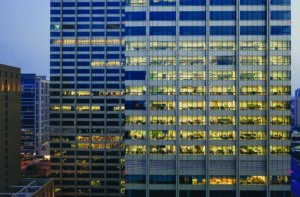So far, I’ve covered the connectivity, sensors and digital hub of a BEMS, a building energy management system. Now, let’s talk about what that infrastructure should be used for. It’s a concept dear to everyone: comfort, both physical and operational.
Let’s take the first one, physical comfort. You’re likely reading this in some climate controlled room, with the temperature at a set point somewhere between 68 and 78o F (20-26o C) – the range of maximum worker productivity. But, that ideal setting can vary, depending on who’s doing what. Some of the most efficient data centers run at temperatures as high as 95o F (35o C), too hot for comfort.
In general, higher temperatures lead to lower productivity. So, too, can having the temperature too low. Research recommends something around 72o F. However, such factors as the makeup of the workforce, the task being done, the presence of windows, and even the outside seasons can impact what that ideal set point will be for maximum productivity.
The efficient data center is a performance leader because it doesn’t use air conditioning, instead depending on fans. So, in the summer it sometimes gets hot. I’m not saying you should follow that lead (unless, perhaps, you’re running a data center!). What I am saying is that the most comfortable temperature may not be the one that is the most cost effective when heating and cooling are considered.
Now, let’s talk about the second category: operational comfort. It’s as important as physical comfort and has as big or bigger impact on productivity. Operational comfort involves equipment and expectations. When you walk into a room, you assume the lights will work. If there’s a computer, you take for granted it will run and connect to the network. And speaking of that, a working wireless network is another expectation. That is because about 70% of the U.S population uses a smartphone, a figure that will soon be true not just for developed counties but for the entire world.
A capable BEMS can provide a solution that improves both physical and operational comfort while conserving cash. As noted in the Navigant Research Leaderboard Report: Building Energy Management Systems, a BEMS directs “automated and/or manual improvements to system operations.” Those improvements can involve the heating, ventilating, and air conditioning (HVAC) systems, as well as lighting and other office infrastructure.
Regarding physical comfort, a BEMS can help in various ways. For example, a temperature setback can save as much as 10 percent a year in heating and cooling costs, but intelligent management is needed to maximize savings without decreasing physical comfort. With ventilation, too few air exchanges run the risk of sick building syndrome. Too many, on the other hand, send money effectively flying out the window. Again, a smart solution can hit an ideal balance. As for lights, the U.S. Department of Energy says that shutting these off in rooms that are unoccupied for as little as a few seconds can save money. A BEMS working with data from occupancy sensors can achieve such savings while avoiding the problem of having people trying to work in the dark.
As for operational comfort, as the lighting example shows the right BEMS and technology can combine to ensure lights, computers, networks and other essentials work as needed and when needed. For instance, monitoring systems can improve maintenance by problem alerts to the proper personnel. Such monitoring can also produce data that can be used to spot and fix issues before they lead to the breakdown of occupational equipment and systems.
Check out SmartStruxure for large and critical buildings as well as our SmartStruxure Lite for small and medium buildings to see just how you can boost comfort – both physical and operational.
In my next post, I’ll look at how the right software can also help.


